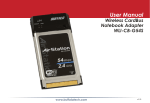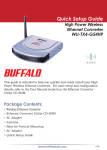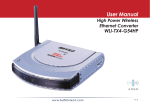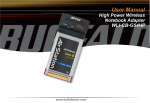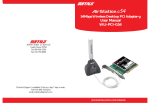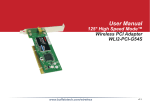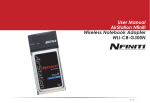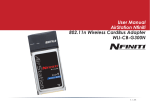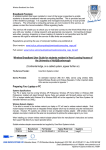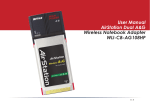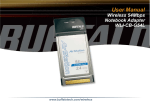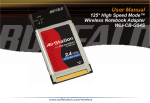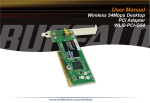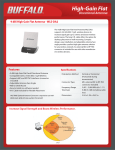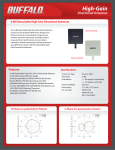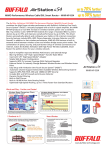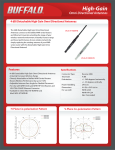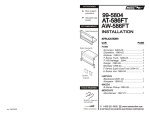Download Black Box WLI-CB-G54HP User's Manual
Transcript
User Manual High Power Wireless Notebook Adapter WLI-CB-G54HP www.buffalotech.com v 2.3 Introduction The High Power Wireless Notebook Adapter is a CardBus card that provides wireless connectivity to notebook PCs. It uses an internal amplifier to increase the radio output so that it can connect to APs/Wireless Routers further away and transfer data at range faster than traditional 802.11g CardBus cards. Buffalo Technology recommends use with the High Power Wireless Router (WZR-HP-G54) for maximum range and performance. An external antenna can be added to the High Power Wireless Notebook Adapter to increase its range and versatility. Antenna information can be found on page 24. Getting Started • Insert the AirNavigator CD into the CD-ROM drive of your computer. The AirNavigator Setup Wizard should launch automatically. • To launch the AirNavigator Setup Wizard manually, click Start, then Run. Type “D:\ Setup.exe”, where D is the drive letter assigned to your CDrom. • Click OK to launch the wizard. Installing Wireless Drivers • Select Install Wireless Drivers. Installing Wireless Drivers • Click Next to install a driver for the CardBus. • Select Agree and click Next to continue the process after reviewing the license agreemennt. • A window will appear prompting the insertion of the Wireless CardBus Adapter. Firmly insert the AirStation Card into a CardBus slot on your notebook. WinXP Setup 2. Installing the Wireless Notebook Adapter: • Turn on your notebook PC. Insert the AirStation card, with the Buffalo logo facing up, into an available CardBus slot. The Found New Hardware Wizard will launch. • Select Install the software automatically. Click Next. Installing Wireless Drivers • Select the device you want to install. If multiple drivers are listed, select the most recent driver version. Click the Next button. • If a window opens, stating that your driver does not pass Windows Logo testing, click the Continue Anyway button. When the Wireless Notebook Adapter is successfully installed, click the Finish button. Restart your PC if prompted. Connecting Wireless Clients to your Network Buffalo supports three different methods for connecting your wireless client device to your network. If your AP supports it, use the simple, utterly secure AOSS to connect. Install the Client Manager from your AirNavigator CD (page 9) and turn to page 12. You may also use the Client Manager software from your AirNavigator CD to configure your network manually. See page 17 for more on Client Manager. If you’re running Windows XP on your PC, you may use its built-in Zero Configuration tool to connect to your router/AP. See page 22 for more on Zero Configuration. Client Manager Client Manager can be used to survey and connect to available access points, configure WPA/WEP encryption, and create connection profiles. Note: When Client Manager is installed, Windows XP Wireless Zero Configuration is automatically disabled. Installing Client Manager Insert the AirNavigator CD into the CDROM drive of you computer. If the Air Navigator Setup Wizard does not launch automatically, launch it manually by clicking Start and then Run. Enter D:\ Setup.exe in the dialog box that appears. Click OK. Select Install Wireless Client Manager. Client Manager • Once the Client Manager Installer launches, click Next. • Press Agree to accept the license agreement and continue installation. 10 Client Manager • Click OK when Client Manager installation is complete. • Press Exit Setup to exit AirNavigator. • Client Manager is now installed and running. Right-click on its icon (the black antenna) to use it. 11 Using AOSS AOSS (AirStation One-Touch Secure System) is a simple, one-touch setup for connecting wireless clients to an access point while enforcing the most secure possible connection encryption type. Users no longer need to worry about choosing the proper security protocols, IP addresses, or SSID. AOSS determines the optimal connection and configures itself in seconds. If your router doesn’t support AOSS, turn to page 15 to configure your connection manually with Client Manager or page 22 to use Wireless Zero Config. The AOSS button for this wireless client is in its Client Manager software. Start Client Manager by right clicking on the black antenna icon in your System Tray, or by launching the Client Manager from your Start Menu: Programs >> Buffalo >>AirStation Utility >> Client Manager. 12 Using AOSS • From the Status Screen, select the Profiles tab. • Initiate AOSS by clicking the blue AOSS button on the Client Manager’s screen. The AOSS wizard will appear. • Now, press the AOSS button on the Access Point. Hold it down until the AOSS LED begins to flash. 13 Using AOSS Once AOSS is complete (about 30 seconds), the connection is archived as a profile for later use. To minimize Client Manager to the system tray, click the ‘X’ in the top right corner. Notes: AOSS will scan for an AOSS partner for about two minutes. If it times out before finding one, just press the AOSS buttons again. Output power is reduced to 25% of normal during AOSS for security reasons. If you’re having trouble making an AOSS connection, temporarily move the devices closer together. AOSS will automatically use the highest level of security available for all currently connected wireless devices. If you have trouble connecting with AOSS, temorarily disable all personal firewalls on your PC, such as ZoneAlarm or Microsoft Personal Firewall. These programs may be re-enabled after AOSS has finished. 14 Client Manager Configuration You may use Client Manager to configure your wireless network. Client Manager consists of the Status page, the Survey page, and the Profiles page. You can access each page by clicking the corresponding button on Client Manager. In addition to these pages, several dialog boxes are also available. You can access the Edit Profile dialog box, New Profile dialog box, IP Configuration dialog box, or WEP Configuration dialog box using the Client Manager pages. You may also initiate AOSS. Status Page Click Status to open this page. By default, this page is displayed when you start Client Manager. Details of connection status are displayed. This page only displays connection information; no changes to settings are made here. This page includes the following components: • Adapter Name – Displays the part number of the wireless adaptor that is being used. 15 Client Manager Configuration • Network Type - Displays whether network is in Ad-Hoc or Infrastructure mode. • Rate – The speed of communication between wireless devices. If the Client Manager is • • • • • not connected to a remote wireless device (access point or another client), no rate will be displayed. Channel – The channel that the two wireless clients are using for communication. If the Client Manager is not connected to a remote wireless device, no channel will be displayed. Channels 1-11 may be used. Security – The type of encryption in use. If the Client Manager is not connected to a remote wireless device, then ‘No Encryption’ will be displayed. IP Address – The IP address of the machine the Client Manager is installed on. If the Client Manager is not connected to a network with DHCP, then no IP address will be displayed. MAC Address – The MAC address of the wireless client device inside the computer Client Manager is installed on. If no wireless device is present in the computer, then no MAC Address will be displayed. Signal Strength – Displays the signal strength of the peak signal level the wireless adapter receives from the wireless device to which it is connected. Next to the signal level is the wireless hardware being used for this measurement. 16 Client Manager Configuration Click the Scan tab to open this page. Here, you can survey the area, display available access points, and connect to available access points. This page includes the following components: • Wireless SSID – The SSID is the “name” of a wireless network. Each wireless device on a network must use identical SSIDs to successfully communicate. • Wireless Mode – Displays available modes for each available remote wireless device. • Strength – Displays the relative signal strength of the wireless networks. • Encryption – Displays whether the wireless network is using any sort of encryption. Click Connect to connect to a highlighted SSID, or Refresh to update the list of available wireless devices. 17 Client Manager Configuration This dialog will open for you to enter any necessary encryption information. The correct encryption type should already be selected automatically in the Encryption Method drop down list. Only change this setting if necessary. The Encryption Key is where the actual key for the wireless network should be entered. Some wireless networks allow you to enter multiple keys; four separate fields are available for this. If your network only uses one encryption key, then please use the first field (#1) to enter your key. on using this wireless network again. The Register Profile option will store this wireless network in your profiles. You will then automatically connect to this network when inside its range. This is recommended if you plan Press the Connect button once you have completed entering encryption information. 18 Client Manager Configuration Profiles Page Click the Profiles tab to open this page. Use this page to access your profiles. Profiles allow you to save the information associated with a specific wireless network so you can quickly and easily connect to that network when you are in that location. The Profiles page allows you to add, delete, and edit your profiles, as well as import and export data. • Connect – Click the Connect button to connect to the selected profile and return to the Status page. • Edit – Click the Edit button to edit the selected profile’s settings. The Edit button also allows you to delete profiles that are no longer used or required. • Add – Click the Add button to add a profile manually. You will need important information such as SSID, encryption settings, and network type. 19 Client Manager Configuration New Profile Dialog Box • Select Profile – Select whether the profile is for a wireless or wired connection. • Profile Name – Enter the name you want to associate with the new profile. • Network Type – Select the network mode you want to associate with the new profile. Select Infrastructure if your network consists of both wired and wireless devices that communicate through a central device, such as an access point. Select Ad-hoc if your network consists of only wireless devices that communicate with each other directly. • Network Name SSID – Enter the SSID of your network. The SSID is the name of your wireless network. All wireless devices on a network must use identical SSIDs to successfully associate with other devices on the network. MYSSID is an example of a valid SSID. • Channel – The channel setting is only used for Ad-hoc connections. When using an Ad-hoc connection, select a channel and make sure the other Ad-hoc devices are configured to use the same channel. Otherwise, use Auto-Channel. • Encryption Method – Displays the types of encryption available. Once encryption is selected, you will be required to enter an Encryption Key. For the Transmission Key Number, 1 is recommended. • OK – Click OK to save your specifications and return to the Profiles page. 20 Client Manager Configuration Advanced Profile Options • Network Tab – Displays the network information tab. A static IP can be specified for this wireless profile here. It is not recommended to change any of these settings unless specified by an administrator. • Browser Tab – Displays settings to change your browser preferences for this wireless profile. A specific home page can be specified when connected to this wireless profile as can specific proxy server addresses. • Printers Tab – Displays the printers tab. A specific default printer can be associated to this profile. Thus, when connected to this profile, a specific printer will be used as the default printer. • OK – Click the OK button to save your specifications and return to the Profiles page. • AOSS Icon – To automatically add the USB wireless client to your network, just click this icon and then hold down the AOSS button on your wireless router for a few seconds. Check your package for an AOSS Manual, which will give more information on using AOSS. 21 Zero Configuration Service Windows XP includes the Zero Configuration Service, a built in serrvice to configure your wireless clients from within Windows. Turn to page 15 if you would rather use Buffalo’s Client Manager to configure your wireless client. • If the Wireless Zero Configuration Service is activated, Windows will scan for available wireless access points once the Wireless CardBus Adapter is properly installed. If Windows detects one or more access points, a networking icon appears within the system tray. “One or more wireless networks are available” will appear as a caption accompanying the icon. • To start Wireless Zero Configuration manually, click Start >> Control Panel >> Administrative Tools >> Services. Select Automatic in the Startup Type field of Wireless Zero Configuration Service. • Right click the networking icon in the taskbar and select View Available Wireless Networks. Select an SSID and click Connect. You may need to check the box indicating you are connecting to an unsecured network. See page 23 if you need to enter an SSID network name or WEP/WPA encryption key. 22 Zero Configuration Service • Click the Advanced tab to enter an SSID network name or WEP/WPA encryption key if necessary. To add an SSID network name that is not listed, click Add. 23 Zero Configuration Service • To configure a WEP/WPA encryption key, select the wireless network and click Configure. • From the pull down menu, select the Network Authentication and Data Encryption types for the wireless network. Enter and confirm the Network Key and Key Index. Click OK when finished. 24 Antenna Information • The WLI-CB-G54HP comes with an external antenna connector. Buffalo Technology sells numerous external antennas that are compatible with this card. The connector type is called an MC-Card Connector. Adding an external antenna can further increase the power and range of this device. Please see the Buffalo Technology Web Page (http://www.buffalotech.com) to compare antennas available for your adapter. 25 Specifications Wireless LAN Interface Standards Compliance IEEE 802.11g Communication Protocol Direct Sequence Spread Spectrum (DS-SS), Half Duplex Frequency Range 2.412-2.462Mhz Transmission Rates 802.11g: 1, 2, 5.5, 11, 18, 24, 36, 48, 54 125* Mode: 13, 20, 27, 40, 54, 80, 110, 125 Access Mode Infrastructure mode, Ad-Hoc Security WEP 128/64 bit, 802.1x, WPA-TKIP/AES Others Interface CardBus Environmental Operation 0-55ºc, 20-80% (non-condensing) 26 Troubleshooting / FAQ Troubleshooting / FAQ Use this section to locate answers to frequently asked questions. What should I do if I already have a version of Client Manager on my PC? Update your Client Manager to the version on the CD. If you do not update your Client Manager, there could be a loss of functionally, as some versions of Client Manager will not work properly with the G54 Wireless Notebook Adapter. Before updating Client Manager, you must uninstall all previous versions of Client Manager. To update your Client Manager, load the Air Navigator CD and select Install Client Manager. Why won't all my network clients work? Some operating systems support only a limited number of network clients. Windows 98/Me: These operating systems support only four network clients. If you install more than four network clients, only the first four clients you install will work. Will Client Manager support all operating systems? Client Manager and the Wireless Notebook Adapter currently support only Windows 98/ ME/2000/XP. They do not currently support Windows NT, Mac OS, or Linux. For more information, refer to the Mac OS and Linux page in the Troubleshooting section of this help file. 27 Troubleshooting / FAQ Where can I attach my external antenna? Insert your external antenna into the antenna connector, located on the back of the G54 Wireless Notebook Adapter. Why won't Client Manager function properly? Windows XP – The Wireless Zero Configuration Service conflicts with Client Manager. Select Start»Control Panel»Administrative Tools»Services to open the Services window. Select Disabled in the Startup Type field of Wireless Zero Configuration Service to disable the Wireless Zero Configuration Service. I have more than one Air Navigator CD. Do I need more than one CD? No. You receive the same Air Navagator CD with each Buffalo Technology access point and wireless adapter. The CDs are identical and you only need one copy. 28 Glossary 10BaseT or 100BaseTx: 802.3 based Ethernet network that uses UTP (Unshielded twisted pair) cable and a star topology. 10 is 10 Mbps and 100 is 100 Mbps. Client: A PC or workstation on a network. 802.1x: The standard for wireless LAN authentication used between an AP and a client. 802.1x with EAP will initiate key handling. DCE (Data Communications Equipment): Hardware used for communication with a Data Terminal Equipment (DTE) device. Cross-Over Wiring: A UTP cable that has its transmit and receive pair crossed to allow communications between two devices. Default Gateway: The IP Address of either the nearest router or server for the LAN. Ad-Hoc Network: The wireless network based on a peer-to-peer communications session. Also referred to as AdHoc. Default Parameter: Parameter set by the manufacturer. Bandwidth: The transmission capacity of a computer or a communication channel, stated in Megabits per second (Mbps). BSS (Basic Service Set): An 802.11 networking framework that includes an Access Point. Bus Mastering: A system in which the specified Input/Output device (e.g. NIC Card) can perform tasks without the intervention of the CPU. Destination Address: The address portion of a packet that identifies the intended recipient station. DHCP (Dynamic Host Configuration Protocol): Based on BOOTP, it uses a pool of IP addresses, which it assigns to each device connected to it, and retrieves the address when the device becomes dormant for a period of time. DNS (Domain Name System): System used 29 Glossary to map readable machine names into IP addresses stated in Megabits per second (Mbps). BSS (Basic Service Set): An 802.11 networking framework that includes an Access Point. Driver: Software that interfaces a computer with a specific hardware device. DSSS (Direct Sequence Spread Spectrum): Method of spreading a wireless signal into wide frequency bandwidth. Bus Mastering: A system in which the specified Input/Output device (e.g. NIC Card) can perform tasks without the intervention of the CPU. DTE (Data Terminal Equipment): Device that con10BaseT or 100BaseTx: 802.3 based Ethernet network that uses UTP (Unshielded twisted pair) cable and a star topology. 10 is 10 Mbps and 100 is 100 Mbps. Client: A PC or workstation on a network. Cross-Over Wiring: A UTP cable that has its transmit and receive pair crossed to allow communications between two devices. 802.1x: The standard for wireless LAN authentication used between an AP and a client. 802.1x with EAP will initiate key handling. DCE (Data Communications Equipment): Hardware used for communication with a Data Terminal Equipment (DTE) device. Default Gateway: The IP Address of either the nearest router or server for the LAN. Ad-Hoc Network: The wireless network based on a peer-to-peer communications session. Also referred to as AdHoc. Default Parameter: Parameter set by the manufacturer. Bandwidth: The transmission capacity of a computer or a communication channel, Destination Address: The address portion of 30 Glossary a packet that identifies the intended recipient station. in a TCP/IP network, typically by a DHCP server. DHCP (Dynamic Host Configuration Protocol): Based on BOOTP, it uses a pool of IP addresses, which it assigns to each device connected to it, and retrieves the address when the device becomes dormant for a period of time. ESS (Extended Service Set): A set of two or more BSSs that form a single sub-network. ESS-ID is user identification used in the ESS LAN configuration. Ethernet: The most widely used architecture for Local Area Networks (LANs). It is a shared-media network architecture. The IEEE 802.3 standard details its functionality. DNS (Domain Name System): System used to map readable machine names into IP addresses Driver: Software that interfaces a computer with a specific hardware device. Ethernet cable: A wire similar to telephone cable that carries signals between Ethernet devices. DSSS (Direct Sequence Spread Spectrum): Method of spreading a wireless signal into wide frequency bandwidth. File and Print Sharing: A Microsoft application that allows computers on a network to share files and printers. DTE (Data Terminal Equipment): Device that controls data flowing to and from a computer. Firmware: Programming inserted into programmable read-only memory, thus becoming a permanent part of a computing device. Dynamic IP Address: An IP address that is automatically assigned to a client station 31 Glossary Frame: A fixed block of data, transmitted as a single entity. Also referred to as packet. Full-Duplex: To transmit on the same channel in both directions simultaneously. Infrastructure: A wireless network or other small network in which the wireless network devices are made a part of the network through the Access Point. ISP (Internet Service Provider): A company that provides access to the Internet and other related services. Gbps (Giga Bits per second): One billion bits per second. Half-duplex: To transmit on the same channel in both directions, one direction at a time. IV (Initialization Vector): The header section of a message packet. LAN (Local Area Network): A group of computers and peripheral devices connected to share resources. Hub: A device which allows connection of computers and other devices to form a LAN. LED (Light Emitting Diode): The lights on a hardware device representing the activity through the ports. IEEE (Institute of Electrical and Electronics Engineers): The professional organization which promotes development of electronics technology. MAC (Medium Access Control) Address: A unique number that distinguishes network cards. IP (Internet Protocol) Address: A unique 32-binary-digit number that identifies each sender or receiver of information sent in packets. Mbps (Mega Bits Per Second): A measurement of millions of bits per second. 32 Glossary MDI/X (Media Dependent Interface/Crossover): Port on a network hub or switch that crosses the incoming transmit lines with the outgoing receive lines. Packet Filtering: Discarding unwanted network traffic based on its originating address or its type. PCI (Peripheral Component Interconnect): A bus that is connected directly to the CPU. MHz (MegaHertz): One million cycles per second. MIB II: A database containing performance information and statistics on each device in a network. MIPS (Million Instructions Per Second): A measurement of processing speed. PCMCIA (Personal Computer Memory Card International Association) Card: Removable module that adds features to a portable computer. Ping (Packet Internet Groper): An Internet utility used to determine whether a particular IP address is online. NAT (Network Address Translation): An internet standard that enables a LAN to use one set of IP addresses for internal traffic and a second set for external traffic. Plug and Play: Hardware that, once installed (“plugged in”), can immediately be used (“played”), as opposed to hardware that requires manual configuration. NIC (Network Interface Card): An expansion card connected to a computer so the computer can be connected to a network. PoE (Power over Ethernet): A mechanism to send DC power to a device using a CAT5 Ethernet cable. Packet: A block of data that is transferred as a single unit, also called a frame or a block. 33 Glossary transmission device. PPPoE (Point-to-Point Protocol over Ethernet): A specification for connecting users on an Ethernet line to the Internet through a common broadband medium. ROM (Read Only Memory): Permanent memory. Router: Device that can connect individual LANs and remote sites to a server. Protocol: A standard way of exchanging information between computers. Roaming: The ability to use a wireless device while moving from one access point to another without losing the connection. RADIUS (Remote Authentication Dial In User Service): A server that issues authentication key to clients. Script: A macro or batch file containing instructions and used by a computer to perform a task. RAM (Random Access Memory): Non-permanent memory. Repeater Hub: A device that collects, strengthens and transmits information to all connected devices, allowing the network to be extended to accommodate additional workstations. Server: Any computer that makes files or peripheral devices available to users of the network and has a resident Network OS. SMTP (Simple Mail Transfer Protocol): The protocol used to define and deliver electronic mail (E-mail) from one location to another. RC4: The encryption algorithm that is used in WEP. RJ-45 connector: An 8-pin connector used between a twisted pair cable and a data SNMP (Simple Network Management Protocol: An application layer protocol that outlines the formal structure for communi34 Glossary cation among network devices. encryption method replacing WEP. TKIP uses random IV and frequent key exchanges. Static IP Address: A permanent IP address is assigned to a node in a TCP/IP network. Also known as global IP. Topology: The shape of a LAN (Local Area Network) or other communications system. STP (Shielded Twisted Pair): Twisted Pair cable wrapped in a metal sheath to provide extra protection from external interfering signals. Twisted Pair: Cable that comprises 2 or more pair of insulated wires twisted together. Subnet Mask: An eight-byte address divided into 4 parts separated by periods. TCP/IP (Transmission Control Protocol/Internet Protocol: Protocol used by computers when communicating across the Internet or Intranet. UDP (User Datagram Protocol): A communication method (protocol) that offers a limited amount of service when messages are exchanged between computers in a network. UDP is used as an alternative to TCP/IP. TFTP (Trivial File Transfer Protocol): Simple form of FTP (File Transfer Protocol), which Uses UDP (User Datagram Protocol), rather than TCP/IP for data transport and provides no security features. Uplink: Link to the next level up in a communication hierarchy. UTP (Unshielded Twisted Pair) cable: Two or more unshielded wires twisted together to form a cable. TKIP (Temporal Key Integrity Protocol): An WAN (Wide Area Network): A networking 35 system covering a wide geographical area. WEP (Wired Equivalent Privacy): An encryption method based on 64 or 128-bit algorithm. Web Browser: A software program that allows viewing of web pages. Wi-Fi (Wireless Fidelity): An organization that tests and assures interoperability among WLAN devices. Wire Speed: The maximum speed at which a given packet can be transferred using Ethernet and Fast Ethernet standard specifications. WLAN (Wireless LAN): A LAN topology using wireless devices. VPN (Virtual Private Network): A security method to connect remote LAN users to a corporate LAN system. 36 FCC / CE Information Federal Communication Commission Interference Statement This equipment has been tested and found to comply with the limits for a Class B digital device, pursuant to Part 15 of the FCC Rules. These limits are designed to provide reasonable protection against harmful interference in a residential installation. This equipment generates, uses and can radiate radio frequency energy and, if not installed and used in accordance with the instructions, may cause harmful interference to radio communications. However, there is no guarantee that interference will not occur in a particular installation. If this equipment does cause harmful interference to radio or television reception, which can be determined by turning the equipment off and on, the user is encouraged to try to correct the interference by one of the following measures: • Reorient or relocate the receiving antenna. • Increase the separation between the equipment and receiver. • Connect the equipment into an outlet on a circuit different from that to which the receiver is connected. • Consult the dealer or an experienced radio/TV technician for help. FCC Caution: To assure continued compliance, (example - use only shielded interface cables when connecting to computer or peripheral devices). Any changes or modifications not expressly approved by the party responsible for compliance could void the user’s authority to operate this equipment. This device complies with Part 15 of the FCC Rules. Operation is subject to the following two conditions: (1) This device may not cause harmful interference, and (2) this device must accept any interference received, including interference that may cause undesired operation. 37 FCC / CE Information IMPORTANT NOTE: FCC RF Radiation Exposure Statement: This equipment complies with FCC RF radiation exposure limits set forth for an uncontrolled environment. This equipment should be installed and operated with a minimum distance of 20 centimeters between the radiator and your body. This transmitter must not be co-located or operating in conjunction with any other antenna or transmitter. R&TTE Compliance Statement This equipment complies with all the requirements of the DIRECTIVE 1999/5/EC OF THE EUROPEAN PARLIAMENT AND THE COUNCIL of 9 March 1999 on radio equipment and telecommunication terminal Equipment and the mutual recognition of their conformity (R&TTE). The R&TTE Directive repeals and replaces in the directive 98/13/EEC (Telecommunications Terminal Equipment and Satellite Earth Station Equipment) As of April 8, 2000. Safety This equipment is designed with the utmost care for the safety of those who install and use it. However, special attention must be paid to the dangers of electric shock and static 38 FCC / CE Information electricity when working with electrical equipment. All guidelines of this manual and of the computer manufacturer must therefore be allowed at all times to ensure the safe use of the equipment. EU Countries intended for use The ETSI version of this device is intended for home and office use in Austria, Belgium, Denmark, Finland, France (with Frequency channel restrictions), Germany, Greece, Iceland, Ireland, Italy, Luxembourg, Norway, The Netherlands, Portugal, Spain, Sweden, Switzerland and United Kingdom. The ETSI version of this device is also authorized for use in EFTA member states Iceland, Liechtenstein, Norway and Switzerland. EU Countries Not intended for use None. Potential restrictive use France: Only channels 10,11,12, and 13. 39 Warranty Information Buffalo Technology (USA), Inc. products comes with a two-year limited warranty from the date of purchase. Buffalo Technology (USA), Inc. warrants to the original purchaser the product; good operating condition for the warranty period. This warranty does not include non-Buffalo Technology (USA), Inc. installed components. If the Buffalo product malfunctions during the warranty period, Buffalo Technology (USA) Inc. will, replace the unit, provided the unit has not been subjected to misuse, abuse, or non-Buffalo Technology (USA), Inc. authorized alteration, modifications or repair. All expressed and implied warranties for the Buffalo Technology (USA) Inc. product line including, but not limited to, the warranties of merchantability and fitness of a particular purpose are limited in duration to the above period. Under no circumstances shall Buffalo Technology (USA), Inc. be liable in any way to the user for damages, including any lost profits, lost savings or other incidental or consequential damages arising out of the use of, or inability to use the Buffalo products. In no event shall Buffalo Technology (USA), Inc. liability exceed the price paid for the product from direct, indirect, special, incidental, or consequential damages resulting from the use of the product, its accompanying software, or its documentation. Buffalo Technology (USA), Inc. does not offer refunds for any product. 40 Technical Support Buffalo Technology offers toll-free technical support 24 hours a day, 7 days a week for this product. Customers in the United States and Canada can obtain technical support using the following information: Web: E-mail: Telephone: www.buffalotech.com [email protected] 1(866)-752-6210 (USA & Canada only) FCC Warning This device complies with part 15 of the FCC Rules. Operation is subject to the following two conditions: (1) This device may not cause harmful interference, and (2) this device must accept any interference received, including interference that may cause undesired operation. GPL Statement This product uses GPL/LGPL software. Please see the GNU LICENSE document on the LinkNavigator CD-ROM for more information concerning the terms of the license. To obtain a copy of our open source software, please send a message to [email protected] to inquire about obtaining a package. 41









































